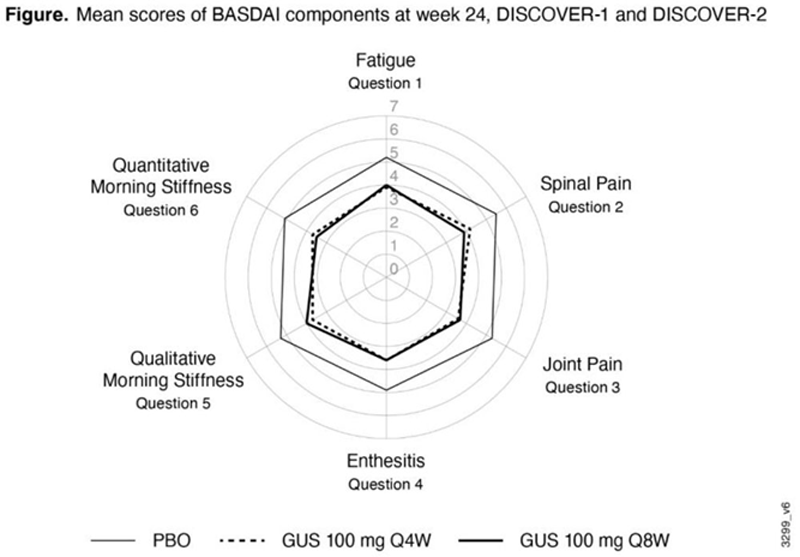

Background: The monoclonal antibody guselkumab (GUS; anti- IL-23p19-subunit) is approved to treat psoriatic arthritis (PsA). Post hoc analyses of DISCOVER-1&2 suggested that GUS may be effective in improving symptoms of axial manifestation of PsA.
Objectives: Evaluate the efficacy of GUS across components of the Bath Ankylosing Spondylitis Disease Activity Index (BASDAI) in improving symptoms of axial manifestations of active PsA patients (pts) using data from Phase 3, randomized, placebo (PBO)-controlled studies.
Methods: DISCOVER-1&2 enrolled pts with active PsA; pts were randomized to subcutaneous injections of guselkumab 100 mg every 4 weeks (Q4W) or at Wk0, 4, and Q8W, or PBO. These post hoc analyses included pts who were identified by the investigator as having axial symptoms and sacroiliitis (prior X-ray or MRI or screening X-ray). BASDAI scores were assessed at Wks 0, 8, 16, 24, and 52. Mean BASDAI component scores through Wk52 are reported by treatment group. Pooled data from the two studies are reported. Mean BASDAI component scores are reported using observed data; total BASDAI scores with missing components were set to missing. The proportion of pts achieving ≥50% improvement in BASDAI (BASDAI 50) was also determined; pts with missing data or who met the treatment failure criteria (discontinued study agent or used prohibited medications) were considered nonresponders at all subsequent timepoints.
Results: These analyses included 312 pts from DISCOVER-1&2 (103 GUS Q4W, 91 GUS Q8W, 118 PBO); mean total BASDAI scores at Wk0 were 6.4, 6.5, and 6.6, respectively. Demographics and mean baseline BASDAI component scores (ie, fatigue, spinal pain, joint pain, enthesitis, qualitative morning stiffness, and quantitative morning stiffness) were similar across treatment groups (
Conclusion: Among PsA pts with axial symptoms and sacroiliitis (via investigator-confirmed imaging) in the DISCOVER-1&2 trials, GUS treatment resulted in lower mean scores for all six BASDAI components compared with PBO as early as Wk 8 and through Wk24, with mean scores maintained at Wk52.
REFERENCES:
[1]Helliwell P, et al. Ann Rheum Dis. 2020; 79; Suppl 1.
[2]Mease PJ, et al. Arthritis Rheumatol. 2020; 72 (suppl 10).
Baseline demographic and disease characteristics for patients who were identified by physicians as having symptoms consistent with spondylitis and had sacroiliitis confirmed via prior radiograph/MRI or screening radiograph
| GUS Q4W | GUS Q8W | Placebo | |
| Patients, n | 103 | 91 | 118 |
| Male, n (%) | 68 (66) | 54 (59) | 69 (59) |
| Age, years | 44.9 ± 11.8 | 45.0 ± 10.7 | 45.3 ± 11.0 |
| BASDAI | |||
| Patients, n | 95 | 84 | 110 |
| Score | 6.4 ± 1.7 | 6.5 ± 1.8 | 6.6 ± 1.5 |
| BASDAI Components | |||
| Fatigue | 6.4 ± 2.0 | 6.7 ± 1.9 | 6.5 ± 1.9 |
| Spinal pain | 6.6 ± 2.1 | 6.5 ± 2.3 | 6.7 ± 2.0 |
| Joint pain | 6.3 ± 1.9 | 6.5 ± 2.2 | 6.8 ± 1.7 |
| Enthesitis | 6.3 ± 2.1 | 6.4 ± 2.2 | 6.3 ± 2.2 |
| Qualitative morning stiffness | 6.8 ± 2.1 | 6.7 ± 2.5 | 7.0 ± 2.0 |
| Quantitative morning stiffness | 6.2 ± 2.9 | 5.7 ± 2.9 | 6.1 ± 2.8 |
Data are mean ± standard deviation unless otherwise noted.
BASDAI, Bath ankylosing spondylitis disease activity index

Disclosure of Interests: Frank Behrens Speakers bureau: AbbVie, Boehringer Ingelheim, Bristol Myers Squibb, Celgene, Chugai, Eli Lilly, Galapagos, Genzyme, Gilead, Janssen, MSD, Novartis, Pfizer, Roche, Sanofi, and UCB, Consultant of: AbbVie, Boehringer Ingelheim, Bristol Myers Squibb, Celgene, Chugai, Eli Lilly, Galapagos, Genzyme, Gilead, Janssen, MSD, Novartis, Pfizer, Roche, Sanofi, and UCB, Grant/research support from: Celgene, Chugai, Janssen, Pfizer, and Roche, Philip J Mease Consultant of: AbbVie, Amgen, Boehringer Ingelheim, Bristol Myers Squibb, Eli Lilly, Galapagos, Gilead, GlaxoSmithKline, Janssen, Novartis, Pfizer, SUN, and UCB, Grant/research support from: AbbVie, Amgen, Bristol Myers Squibb, Eli Lilly, Galapagos, Gilead, Janssen, Novartis, Pfizer, SUN, and UCB, Philip Helliwell Consultant of: Galapagos, Janssen, Novartis, Grant/research support from: AbbVie, Janssen, Pfizer, May Shawi Shareholder of: Johnson & Johnson, Employee of: Janssen Global Services, Wim Noel Shareholder of: Johnson & Johnson, Employee of: Janssen Scientific Affairs, Soumya D Chakravarty Shareholder of: Johnson & Johnson, Employee of: Janssen Scientific Affairs, Alexa Kollmeier Shareholder of: Johnson & Johnson, Employee of: Janssen Research & Development, Xie L Xu Shareholder of: Johnson & Johnson, Employee of: Janssen Research & Development, Stephen Xu Shareholder of: Johnson & Johnson, Employee of: Janssen Research & Development, Yanli Wang Employee of: IQVIA providing statistical support (funded by Janssen), Xenofon Baraliakos Consultant of: AbbVie, Amgen, Bristol Myers Squibb, Eli Lilly, Galapagos, Gilead, Janssen, Novartis, Pfizer, and UCB, Grant/research support from: AbbVie, Amgen, Bristol Myers Squibb, Eli Lilly, Galapagos, Gilead, Janssen, Novartis, Pfizer, and UCB.